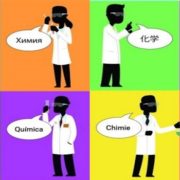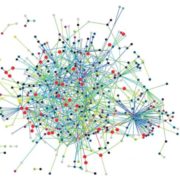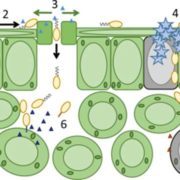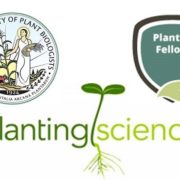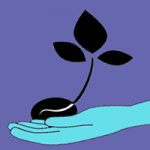Letter to the editor: Challenges facing LGBTQ+ early-career scientists and how to engage in changing the status quo
This letter by Sterling Field and Alex Rajewski is the 3rd in our series on diversity, equity, and inclusion in STEM disciplines. Read the editorial call for letters here: Sowing the seeds of equity and diversity in academia and STEM disciplines.
Field S, Rajewski A (2021). Challenges facing LGBTQ+ early-career scientists and how to engage in changing the status quo. Plant Cell. First published March 26, 2021 doi: 10.1093/plcell/koab094.
Dear Editor,
Lesbian, Gay, Bisexual, Transgender, Queer, and other members of this community (LGBTQ+) in the United States have recently gained protections against discrimination in the classroom (Ali, 2010; Lhamon and Gupta, 2016; see also Phillips, 2017) while LGBTQ+ employees gained protected status under the 1964 Civil Rights Act in a 2020 Supreme Court decision (Totenberg, 2020; Figure 1A). Along with these changes in civil protections, only recently have studies begun to document the challenges faced by the LGBTQ+ Science, Technology, Engineering, and Math (STEM) community (Cech and Waidzunas, 2011). We are writing this letter to both celebrate LGBTQ+ Pride month and to discuss some of the challenges still faced by the LGBTQ+ community in plant science. We also want to emphasize that these challenges intersect with other underrepresented communities in science. Though our experiences are those of white, early-career, cisgender, gay men, we hope to use this place of privilege to advocate for increasing support for the LGBTQ+ community, offer suggestions for LGBTQ+ individuals, and non-LGBTQ+ allies, and highlight helpful advocacy resources for the LGBTQ+ science community.
What we know about LGBTQ+ issues in science
LGBTQ+ students and professionals in STEM encounter discrimination and challenges not faced by their heterosexual, cisgender, and gender-conforming peers (see Mattheis et al., 2020; Cooper et al., 2020 for literature synopsis). Recent work by Cech and Waidzunas (2021) surveyed over 25,000 STEM professionals, including over 1,000 self-identified LGBTQ+ STEM members, and found LGBTQ+ people in STEM were more likely to face career limitations, harassment, and professional devaluation, and were more likely to leave STEM than their non-LGBTQ+ counterparts (Cech and Waidzunas, 2021). Transgender and nonbinary respondents specifically were significantly more likely to experience depressive symptoms and stress from work (Cech and Waidzunas, 2021). In the United States, LGBTQ+ undergraduate students were less likely to remain in college, and as professionals, nearly one-third were not open about their personal identities to their colleagues (Yoder and Mattheis, 2016; Hughes, 2018). Similar to LGBTQ+ STEM professionals, Black STEM professionals experienced more health problems, depressive symptoms, stress from work, and a higher intention to leave STEM than their non-Black counterparts (Cech and Waidzunas, 2021). While a prevailing notion is that personal identities do not factor into academia and research because these environments are “sterile” or “unbiased,” these quantitative data indicate that these identities are a significant factor in who remains and succeeds in STEM.
The barriers faced by early-career LGBTQ+ scientists are often intersectional and may include not only sexual orientation and gender discrimination, but also discrimination based on race, region, age, and socioeconomic status. In the United States, LGBTQ+ people collectively were more likely to live in poverty than cisgender, heterosexual people (21.6% vs. 15.7%, respectively), and poverty levels were even higher for transgender people (29.4%; Badgett et al., 2019). This startling trend of higher poverty rates for LGBTQ+ people remains when the data are broken down by race within the Asian, Black, and White communities, across the rural–urban divide, within most US states, and in all age groups under age 45 years (Badgett et al., 2019). Research has shown these disparities influence which students attend college. While 78% of students in the highest socioeconomic quintile were enrolled in college 3 years after high school, only 28% of those in the lowest socioeconomic quintile were (McFarland et al., 2019). Once enrolled, additional hurdles like food- and housing-insecurity often further hinder students’ progress towards graduation (Dubick et al., 2016; Broton and Goldrick-Rab, 2018). Together, this suggests our goal to diversify science cannot be achieved solely by tackling our implicit biases or making our labs welcoming and affirming environments, although these are positive and necessary steps. A genuine commitment to diversify science will require structural changes in how we select, retain, and fund students and early-career scientists.
For both of us writing this letter, our struggles with “coming out” as gay were layered on top of navigating complex family situations that delayed and almost prevented us from attending graduate school. Sterling grappled with financial responsibilities following a family member’s job loss, which made pursuing a low-paying graduate degree in science for many years a difficult decision. Similarly, Alex delayed attending graduate school in hopes of first rebuilding familial relationships he lost after coming out as gay. Ultimately, both of these situations worked out for the better, but significant barriers to success were present before we had even applied to graduate school. Certainly being accepted to and completing graduate school is a difficult endeavor, but it is important to ask ourselves if all early-career scientists are navigating equivalent difficulties.
We have seen how members of our community can be further marginalized or excluded from science due to their socioeconomic status. For example, there was an undergraduate researcher in a neighboring lab who was clever, dedicated, passionate, and willing to train others, while also taking a full course load and working. After coming out, however, they lost all connection with their family, including all financial and emotional support. This forced them to take a semester off, but even after returning, they still struggled financially. Because their focus was on personal survival instead of classes, their grade-point average (GPA) suffered. Clearly, their GPA did not accurately reflect their talent, drive, or passion. Instead, it was an aggregate marker of academic success and the other struggles in their life while taking classes. The use of GPA in academic admissions decisions in the US is one example of “gatekeeping,” where the use of seemingly objective criteria as metrics of success bias our institutions against students with various disadvantages in society. There is a nascent movement to reform these metrics (discussed in O’Neil, 2016), but ultimately, this student’s goal to attend graduate school was severely impeded because they came out.
These situations demonstrate personal challenges navigating LGBTQ+ identities and socioeconomic issues, but they also reflect how our scientific community is shaped. Students from marginalized groups are required to be more resilient than their peers to succeed in science (discussed in Montgomery, 2020). This is in large part because our institutions were built upon centuries of leadership by scientists who were mostly white, wealthy, able-bodied, cisgender, male, and heterosexual. These implicit values and biases are encoded in the rules and policies of our institutions that often represent unnecessary barriers for underrepresented groups. The larger scientific community can become more inclusive by building and reforming institutions and communities in ways that encourage the success of all community members instead of restricting their access. As we work toward a diverse scientific community, we need to specifically expand how we are selecting, retaining, and funding students. This will require us as LGBTQ+ scientists and non-LGBTQ+ allies to examine how we educate early-career scientists, adding mental, physical, and financial support systems, and to incorporate a better understanding of how different socioeconomic statuses, races, genders, gender identities, and sexual orientations (Figure 1B) impact student achievement.
Resources to help LGBTQ+ scientists (and changes that need to be made)
We encourage you to think about actions to facilitate change at the institutional level, within the classroom, and to take small and meaningful personal steps to make progress for LGBTQ+ scientists. These efforts will require work and leadership from LGBTQ+ scientists and will require allies of the LGBTQ+ community to step up and advocate for these changes. We have proposed some concrete steps that can be taken toward this end and encourage you to consider implementing these, and other actions, at your institutions.
One major change to help diversify science would be to improve funding for early-career scientists to remove this financial gatekeeping barrier. As we have outlined above, many students and early-career scientists must overcome financial barriers, which disproportionately affect members of underrepresented communities. These changes must include advocacy for improved stipends and wages for early-career scientists and changes to who decides how funding is allocated (discussed in Stevens et al., 2021). Other helpful financial improvements include replacing case-by-case fee waivers with free applications and moving away from complex and burdensome reimbursements for campus visits. Beyond funding, we need to change our perspective on who is considered “admissible” into the scientific community by understanding our implicit biases and by including more diverse representatives and perspectives on admissions committees. We need to reassess the metrics used when considering who is a “desirable” candidate, or whom we predict will be “successful” in higher education. We believe these changes will significantly help LGBTQ+ scientists and will ultimately help all marginalized groups in joining the scientific community.
While LGBTQ+ students in biology classrooms report that overt discrimination is rare, they also indicate the biology classroom is not welcoming or accepting for them, and they experience subtle forms of discrimination (Cooper and Brownell, 2016). One way to improve biology classrooms is to implement “groundskeeping-based” active learning as opposed to a “gatekeeping” mentality (Montgomery, 2020). Active learning environments deemphasize the role of the lecturer as the gatekeeper of knowledge. This helps students build peer communities to facilitate discussion and accommodate their identities (Gasiewski et al., 2012 Owens et al., 2020) and can result in positive learning outcomes for LGBTQ+ students (Cooper and Brownell, 2016). This approach still requires the educator to facilitate learning but can offer a better response to the needs of the individual students present (Gasiewski et al., 2012) and help LGBTQ+ students to be more comfortable in the classroom (Cooper and Brownell, 2016). Another change we can implement in the classroom is to discuss contributions by LGBTQ+ as well as BIPOC and women scientists. Improved representation creates role models for students from under-represented communities and helps to improve the success in STEM of students from marginalized communities (discussed in Whittaker and Montgomery, 2014; Barres et al, 2017).
In addition to advocating for these systemic changes, there are personal steps you can take as an LGBTQ+ scientist or ally. A particular challenge is that LGBTQ+ students experience internal struggles navigating their professional environment, including a fear that being out might negatively affect their career in biology (Cooper and Brownell, 2016). If a student were to join your lab, would they know they can be open about who they are? Safe-zone training sessions on your campus or at your local LGBTQ+ center can help you to better understand your students and address ways to make your lab more accepting, open, and inclusive (Ballard et al., 2008). Additionally, including your personal pronouns (e.g., she/her, he/him, they/them) in your email signature and using pronouns when you introduce yourself will help normalize their use and demonstrate to your students they are in a supportive learning environment. You can help students by becoming familiar with local resources for mental, physical, and financial assistance. Awareness of these resources can help when you encounter a student or early-career scientist undergoing a crisis, and regularly discussing these resources reduces their stigma. If you are advertising a job or volunteer position, be thoughtful about the language you use and consider which candidates will have access to the posting. These personal steps can help change your local community to one that welcomes, includes, and retains students and early-career scientists from diverse backgrounds.
Conclusion
When we talk about how to ensure that members of underrepresented communities can find a welcoming place in science, we need to ensure we are building a culture that celebrates diversity and that critically and routinely analyzes the existing structures for biases. When we discuss steps that LGBTQ+ scientists and allies can take to increase diversity in science, we must include advocacy for increased funding, funding not only to recruit but also to retain, and changes in who is at the funding allocation table. Additionally, we need to work to remove financial and societal gatekeeping barriers for joining the scientific community and take steps to make our local community more accepting of people from different backgrounds.
While we strive to make science a better community for LGBTQ+ people, we want to recognize other organizations working to improve the LGBTQ+ science and greater STEM community (Figure 1C). Legal protections for LGBTQ+ students and professionals in the United States are very recent, and there are few studies documenting experiences of LGBTQ+ STEM professionals. It is long overdue for us to focus on building resources and support for the LGBTQ+ STEM community and improving our understanding of how to accommodate and retain LGBTQ+ scientists. Although these changes will require difficult reforms and sometimes painful personal growth, we know that the scientific community can rise to the challenge, and we are optimistic about the future for LGBTQ+ scientists.
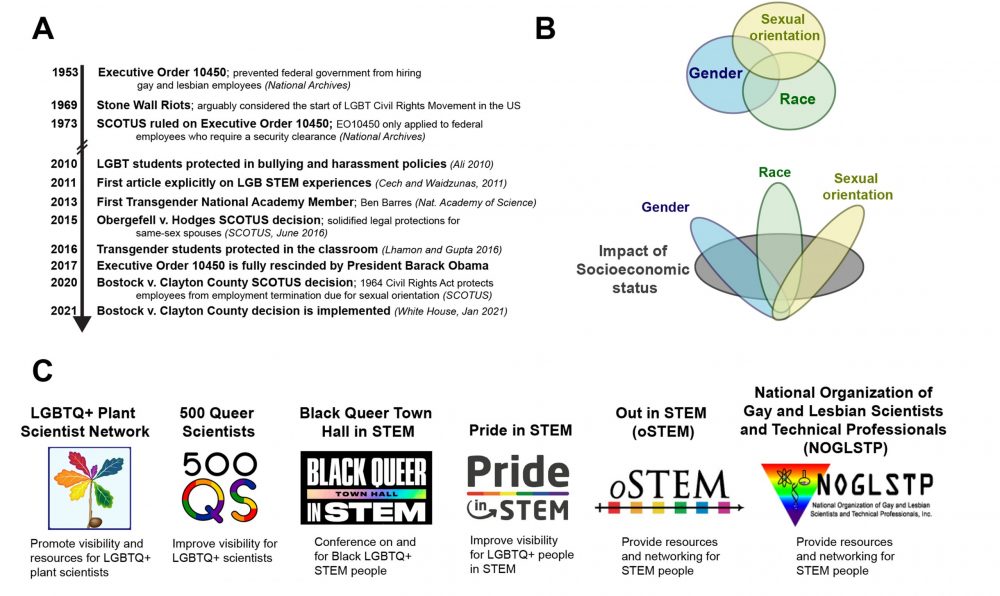
Introduction to LGBTQ+ STEM history, challenges, and resources. (A) Chronology of major events impacting education and employment for LGBTQ+ STEM students and professionals in the United States. SCOTUS: Supreme Court of the United States. (B) (Top) Intersectional view on how to improve diversity in science that only focuses on identities. (Bottom) Updated understanding of intersectional identities that include socioeconomic status as one driving force for recruitment and retention disparities for scientists from diverse racial, gender, and sexual orientations backgrounds. The sizes of overlaps are illustrative and not intended to suggest predicted or actual frequencies of intersectional challenges. This model includes distinct intersectional challenges within and between these groups outside of socioeconomic status. Examples would include the process of “coming out” (only sexual orientation) vs. “coming out” and having this impact your ability to live at home (sexual orientation and socioeconomic). (C) Organizations working to advocate and provide resources for LGBTQ+ scientists and STEM professionals, with their (top) name, (middle) logo, and (bottom) mission.
Sterling Field1 and Alex Rajewski2
1Department of Biochemistry & Cellular and Molecular Biology, The University of Tennessee, Knoxville, TN 37996 USA.
2Department of Botany and Plant Sciences, University of California, Riverside, CA, 92507 USA.
For correspondence: [email protected]
ACKNOWLEDGMENTS
We would like to thank the LGBTQ+ STEM twitter community for helping us identify topics and publications while writing this letter.
Conflict of interest statement. The authors declare they have no conflicts of interest.
REFERENCES
Ali R (2010) Dear colleague letter: Harassment and bullying. U.S. Department of Education. https://www2.ed.gov/about/offices/list/ocr/letters/colleague-201010.html
Badgett MV, Choi SK, Wilson BDM (2019) LGBT poverty in the United States: A study of differences between sexual orientation and gender identity groups. UCLA School of Law https://williamsinstitute.law.ucla.edu/wp-content/uploads/National-LGBT-Poverty-Oct-2019.pdf
Ballard SL, Bartle E, Masequesmay G (2008) Finding queer allies: The impact of ally training and safe zone stickers on campus climate. ERIC ED517219 https://eric.ed.gov/?id=ED517219
Barres B, Montague-Hellen B, Yoder J (2017) Coming out: The experience of LGBT+ people in STEM. Genome Biol. 18: 62.
Broton KM, Goldrick-Rab S (2018) Going without: An exploration of food and housing insecurity among undergraduates. Educational Researcher 47: 121–133.
Cech EA, Waidzunas TJ (2011). Navigating the heteronormativity of engineering: the experiences of lesbian, gay, and bisexual students. Engineering Studies. 3: 1–24.
Cech EA, Waidzunas, TJ (2021). Systemic inequalities for LGBTQ professionals in STEM. Science Advances 7: eabe0933 doi: 10.1126/sciadv.abe0933
Cooper KM, Brownell SE (2016) Coming Out in Class: Challenges and Benefits of Active Learning in a Biology Classroom for LGBTQIA Students. CBE Life Science Education. 15: ar37 doi: 10.1187/cbe.16-01-0074
Cooper KM, Auerbach AJ, Bader JD, Beadles-Bohling AS, Brashears JA, Cline E, Eddy SL, Elliott DB, Farley E, Fuselier L, Heinz HM, et al. (2020) Fourteen recommendations to create a more inclusive environment for LGBTQ+ individuals in academic biology. CBE Life Sciences Education 19: 1–18. doi: 10.1187/cbe.20-04-0062
Dubick J, Mathews D, Cady C (2016) Hunger on campus: The challenge of food insecurity for college students. https://studentsagainsthunger.org/wp-content/uploads/2016/10/Hunger_On_Campus.pdf
Gasiewski JA, Eagan MK, Garcia GA, Hurtado S, Chang MJ (2012) From gatekeeping to engagement: A multicontextual, mixed method study of student academic engagement in introductory STEM courses. Research on Higher Education. 53: 229–261.
Hughes BE (2018) Coming out in STEM: Factors affecting retention of sexual minority STEM students. Science Advances 4: eaao6373 doi: 10.1126/sciadv.aao6373
Lhamon C, Gupta V (2016) Dear colleague letter on transgender students. (Department of Education). https://www2.ed.gov/about/offices/list/ocr/letters/colleague-201605-title-ix-transgender.pdf
Mattheis A, De Arellano DC-R, Yoder JB (2020) A model of queer STEM identity in the workplace. Journal of Homosexuality. 67: 1839-1863.
McFarland J, Hussar B, Zhang J, Wang X, Wang K, Hein S, Diliberti M, Cataldi EF, Mann FB, Barmer A (2019) The condition of education 2019. NCES 2019-144. National Center for Education Statistics.
Montgomery BL (2020). Academic leadership: Gatekeeping or groundskeeping? The Journal of Values-Based Leadership 13: 16.
O’Neil C (2016) Weapons of math destruction: How big data increases inequality and threatens democracy. Crown Publishing.
Owens DC, Sadler TD, Barlow AT, Smith-Walters C (2020) Student motivation from and resistance to active learning rooted in essential science practices. Research in Science Education 50: 253–277.
Phillips, ME (2017). Trump administration rescinds guidance on transgender rights under Title IX. Jackson Lewis P.C. https://www.jacksonlewis.com/publication/trump-administration-rescinds-guidance-transgender-rights-under-title-ix
Stevens KR, Masters KS, Imoukhuede PI, Haynes KA, Setton LA, Cosgriff-Hernandez E, Lediju Bell, MA, Rangamani P, Sakiyama-Elbert SE, Finley SD et al. (2021). Fund Black scientists. Cell 184: 561–565.
Totenberg N (2020) Supreme Court delivers major victory to LGBTQ employees. National Public Radio.
Whittaker JA, Montgomery BL (2014) Cultivating institutional transformation and sustainable STEM diversity in higher education through integrative faculty development. Innovative Higher Education 39: 263–275.
Yoder JB, Mattheis A (2016) Queer in STEM: Workplace experiences reported in a national survey of LGBTQA individuals in science, technology, engineering, and mathematics careers. Journal of Homosexuality 63: 1–27.


